Hello,
Welcome to a very fun edition of Kitchen Projects, my recipe development newsletter.
I am beyond excited about today’s recipe: A tagteam collaboration on the ultimate savoury pie (this time it’s chicken!) with the one and only Rosie Mackean.
On KP+, I’ll be keeping the pie theme going with my recipe for lemon meringue pie. Subscribing is easy and is just £5 a month and you’ll get access to all the KP+ archive and support the the writing every week. I hope to see you there:
Alright, let’s do this.
Love
Nicola
All you need is pie
This week it is - apparently - British Pie Week! Yes, this is one of those totally arbitrary marketing events dreamed up by a pie council (does this exist? Can I be part of it?) somewhere, I have rather enjoyed seeing more and thinking more about pies this week. As well as this, tomorrow is the 14th of March which, when written in ~American~ is “3.14” aka Pi aka Pie Day which means an even further influx of pies. So, it’s only right that this week’s newsletter is about just that ft. the most stunning chicken pie:
We’ve covered pies together before and deep dived into the flaky-style crust (read it here along with an interview with my pie hero Nicole Rucker!) so I wanted to go in a different direction this week - a jolly to the land of savoury pies. I do feel pretty confident about intrepidly exploring the pastry side of things, I wanted to make sure the filling is the absolute best it could be. Although I do love savoury cooking (I always say baking is my job, cooking is my hobby!), I thought it best to get some expert help from one of my favourite recipe developers and chefs out there: Rosie Mackean.
Rosie is a home economist, food stylist, recipe developer and all round cuisine savant. If you’ve never made her recipes before, you’re missing out! They always deliver - her version of mac and cheese, for example, is one of the best things I’ve ever made. EVER. As well as this, Rosie is so wonderfully approachable and has such joie de vivre that you hardly even notice the level of serious technique you’re assimilating when you learn from her! Truly, having her collaborate on this week’s newsletter is a total joy - you are in for a treat!
Over on KP+, I’ll be sharing the recipe for delightful lemon meringue mini pies. They are cute, they are sharp and may finally turn the non lemon-meringue-pie believers among us:
I’ll also be running a special giveaway to KP+ subscribers with the best ever pie dishes - Falcon Enamelware! The team at Falcon will be sending one of their pie sets out to a KP+ subscriber. All you need to do to be in with a chance of winning is be subscribd to KP+ and we’ll pick a name at random
A chat about pie
We’ll kick off this week’s edition with a conversation between Rosie and I as we figured out how to approach the testing for this week’s classic chicken pie. At its heart this newsletter is always about recipe development and the thought process that goes into creating a final recipe so I hope this chat gives you insight into how we brought this recipe to reality:
Nicola: Right. Pies. This week it’s all about the crust for me. This means making a few types of pastry (rough puff-pie dough / a shortcrust / depending on the filling, should it be flavoured?! Should we use some wholewheat?!) and then also whether it should be single or double crusted. What do you think?
Rosie: I think by definition a pie has to have a bottom, unless it’s a pot pie. And in terms of British tradition you can’t ignore suet crust or hot water- they both have such different effects and great flavour!
Nicola: I agree - it shall have a bottom! To be honest, I don’t have any experience with either hot water crust pastry OR suet crust. And I have to admit that I kind of have a fear of super old British cooking, boiled meat puddings and the rest. I’ve always thought some of these old school crusts are just relics of old British tradition, kind of like how Cornish miners used to use the crusty pasty edge as a handle? My main question is… it actually more delicious or is it just traditional?!
Rosie: Suet is amazing! I love it. And veggie suet works well too! It makes an incredibly CRUNCHY crust on top - not super flaky and delicate like puff. More bite to it.
Nicola: Alright I’ll get a box and investigate. Interestingly all suet crust recipes seem to contain raising agents… I’ll have to figure that out.
Rosie: Yes! Also why I love a suet pie option is that it becomes v doughy in the base, like a built-in dumpling…It soaks all the gravy! That way you get crunchy and forgiving in one pie.
Nicola: That sounds good. Like it suits being soggy?!
Rosie: Exactly - it’s a dual purpose pastry. Does a bit of both. And you don’t need to worry about a soggy bottom cos that’s the point. I styled this best of British food cookbook so I’ve been really into the olden vibes, but I am always here for modernisation/accessibility and suet does put people off.
Nicola: It is an old fashioned ingredient - my nanny used to make me suet dumplings and beef stew, the best. Also suet doesn’t actually taste that beefy right? We used to make mince pies with it at Little Bread Pedlar.
Rosie: You might notice a subtle beefiness like dripping potatoes, but nothing intense. It is easily replaceable! Since the British book I also love suet puddings, like jam roly poly and spotted dick. But it’s definitely better to use veggie in those.
Nicola: We made a jam roly poly at work once (head chef loved old school puds) and it looked like a dismembered arm (I will not include the photo). Anyway, let’s talk about your filling. Should pie fillings always be already fully cooked when they go into the oven?
Rosie: Not always but 99% of the time I would say yeah, interestingly things like Cornish pasties and pies with mince fillings often all go in raw. But in the case of home pie making I do think it’s better for it to be cooked. For this week’s chicken pie, the two variables I’m going to investigate is 1) how the meat is cooked (roast/already cooked/poached/braised) and how to get the best out of it. 2) the flour quantity in the sauce - how do we create a luscious gravy that is silky smooth, not too thick…How do we get there!
Nicola: Amazing. What about all the extras / additionals for the filling?
Rosie: Well, I think it’s all more of a preference thing than a technique thing. It’s more of what you grew up with. I was talking about it with Tom (Rosie’s boyfriend) and he said he would imagine it with carrots in.. and I thought I woud never put carrots in my chicken pie, not in a million years! I think those additional ingredients are much more subjective.
Alright, let’s get into the deep diving. I’ll take the pastry and Rosie takes the filling!
The pastry by Nicola
To me, a savoury pie crust doesn’t have to play by the same rules that a sweet pie crust does - I find much more charm and value in a pie crust that interacts with its saucy filling when it’s savoury. Though it needs to have an element of crispness to it, there’s benefits to having a more steamed crust that has been enriched with the gravy. For this, I knew I would have to cast my ‘olden days’ prejudices aside and embrace the heritage ingredients and see what gave the best results - it needs to be on-its-own-delicious but also interacts appropriately with the filling. There were also a few key avenues to investigate - the fat (suet v. butter), the ratios and the technique (shortcrust vs. flaky/puff style), as well as figuring out the whole raising agents thing. Let’s discuss.
The deal with suet
Suet, if you aren’t familiar, is fat that is taken from the kidney and loins area of cows. It’s a super hard, white fat with a really high melting point of 45c-50c so is completely solid at room temperature making it really easy to work with. Vegetable ‘suet’ is made of palm oil which has a melting temperature of 35c, making it a decent swap in for the real stuff. Because of its melting point, suet is extremely easy to work with. Classic suet pastry is made similarly to shortcrust pastry (sticking with the classic 2 parts flour to 1 part butter ratio as a starting point), but instead of rubbing in the butter to create a breadcrumb like mixture, the suet is already in small little 2-3mm pebbles so you simply mix with flour and add water to form a dough. The result is a pastry that is immediately ready to use with plenty of flakiness from the little bits of fat suspended throughout.
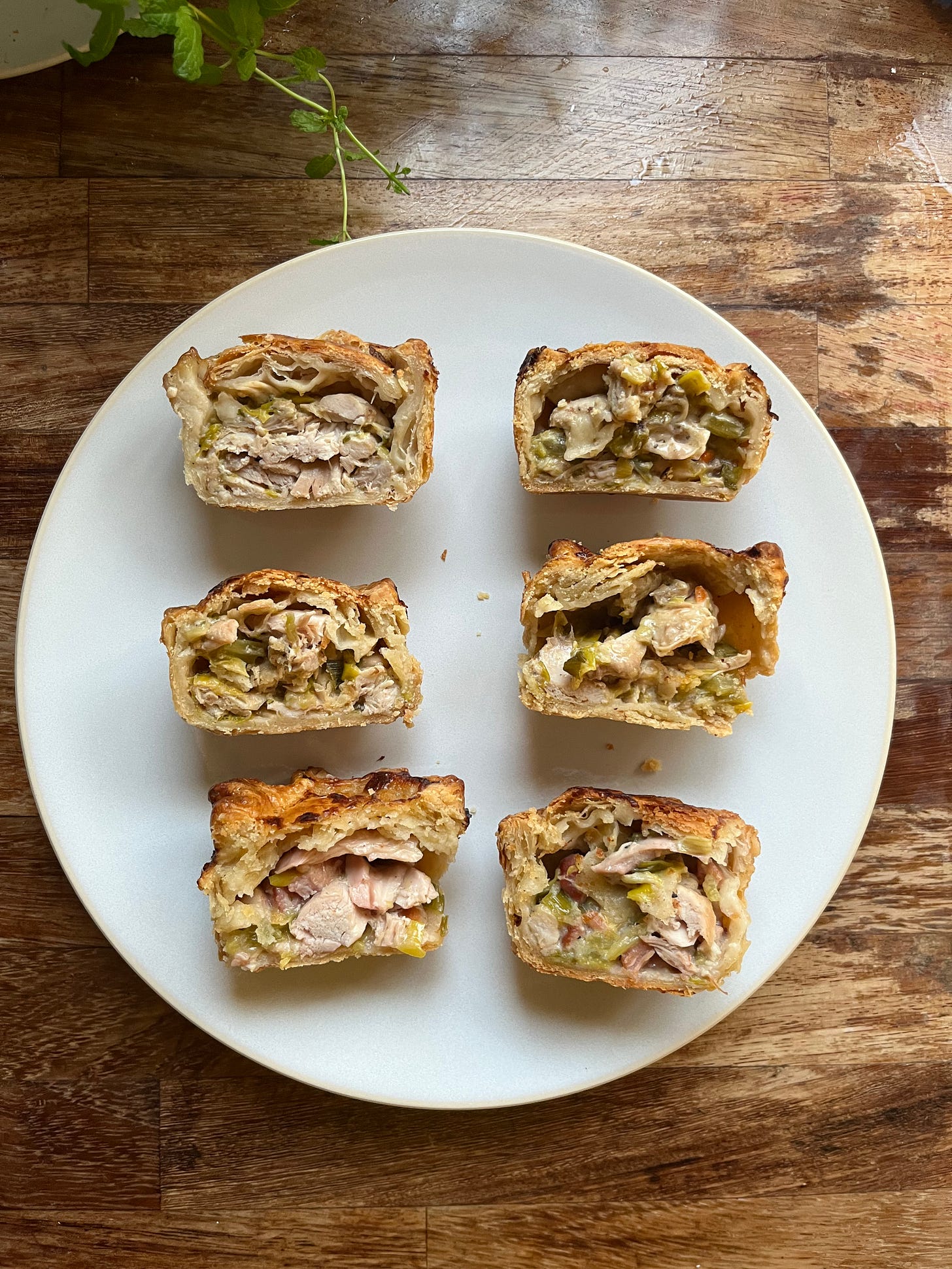
Baked on its own (sans filling), suet pastry is extremely crisp, bordering on hard, even with raising agents which supposedly helps lighten the crust. Although, like shortcrust, fat is well distributed throughout the crust, the lack of water in the suet (it is pure fat) means there is no steam-leavening or flakiness, which would normally be provided by the water evaporating from the butter. However, once filling with its liquid and steam is introduced, suet crust pastry takes on a new lease of life - the hard pastry becomes tender and it has a rich, crisp finish.
I also mixed two identical suet pastries, one with and one without raising agents. Although the difference was - surprisingly - not huge, the raising agents provided a little extra lightness that is missing from the lack of aforementioned water/steam usually provided by the butter. For a steamed suet pudding, I can see how the raising agents would be essential to stop it from being dense and claggy.
Regarding the beef suet, when warm, the flavour is pretty neutral but as it cools the beefiness becomes more apparent and is - in my opinion - a bit off putting. The vegetable suet has a neutral flavour and behaves identically to the beef version, as you would expect a well engineered product. I mean, atora suet has been on the market since 1893, so we can trust they know what they’re doing.
The technique
The main question here was shortcrust (Dense! Rich! Buttery! Melt in the mouth!) vs. flaky (It shatters! So buttery! light!) and whilst this does come down to preference somewhat, I’ve come to realise that you need different pie crusts for different occasions. It is all about context! Eating a pie on the go you definitely need a richer pastry, a densely buttery shortcrust style pastry, for logistics of course. However at home, I tend to prefer a flakier pastry - more impractical but very fun to eat.
So, how about a hybrid?
I find it curious that although a flaky pastry has more butter than shortcrust, shortcrust tastes a lot richer and buttery than flaky. This is because shortcrust pastry is achieved by rubbing the butter into very small fine sandy crumbs with the flour - this technique coats all of the flour particles with butter which prevents gluten from forming resulting in an ultra-short texture that is densely packed with its alternating butter/flour structure. Flaky pastry, on the other hand, has a much more irregular structure with larger pieces of butter alternating with almost fat-less sections of flour/water, resulting in flaky, light pastry, with ‘holes’ from where the larger pieces of butter have evaporated. Suet crust pastry is somewhere in between these two but it does lack flavour and needs help from raising agents

By introducing butter into the mix, we are effectively using the steam held in its larger, flake-inducing butter pieces as a raising agent. This way we get the best of both words - the fluffiness (internal) and hard structure (external) of a suet-crust mixed with the flavour, flakiness and lightness of the butter. This to me is the perfect mixture of a British heritage classic with a texture upgrade.
Don’t want to use suet / can’t find it? Rub half of your butter to fine crumbs then leave the other half as large pieces. This way you get a good mixture of dense buttery/fatty bits and larger, flakier bits!
The filling by Rosie
I absolutely love making pies. I love eating them too, of course, but there’s something about the methodical, ritualistic processes they involve that I find really soothing. Chicken pie is something a lot of people in the UK grew up eating, sometimes with added ham or bacon, otherwise mushrooms or leeks. Always rich, always comforting.
I wanted to make the perfect filling that is achievable in a home kitchen and not ludicrously complicated or time consuming. My 3 main goals to achieve were:
Tender meat and optimum meat flavour
Rich, creamy sauce
Ideal aromatic combination
Let’s do it!
Tender tests
Pies, unlike tarts, do not usually involve a blind baking of the pastry but typically do involve a pre-cooked filling. Because your meat is cooked twice, you need to make sure you are getting get maximum flavour from it, but also preventing it from drying out and overcooking. It’s a fine line to balance, so my aim was to maximise tenderness but also extract as much flavour as possible.
Most recipes lean toward poaching, a method which requires (in my book) fully submerging and cooking the meat gently in a liquid which can be water, stock, milk etc. Whilst it is very effective for a super tender result, you miss out on the delicious flavour compounds from browning. So, I also tried my most favourite method - braising.
Braising is when you brown your meat, then veg, then deglaze the pan with an acid, typically alcohol, add any other aromatics, before finally adding stock. You add less stock than for poaching as the liquid will eventually become your sauce and your meat will usually not be totally submerged. The advantage of braising is that you preserve tenderness by cooking in a liquid, but you also get the maillard rection benefits of browning. I also tested out roasting as I’m sure we’ve all eaten a delicious leftovers pie at least once in our lives! I knew pre-roasting would risk a tougher result after the second cook, but the payoff of schmaltz - that divine roasty toasty chicken fat - was just too tempting.
I generally prefer cooking meat on the bone where possible, so I tested whole bone-in thighs. They (unlike most parts of the chicken) are marbled with fat, have nice density and are more flavourful – plus the bone conducts heat in a gentle way, generally achieving a juicier and more flavourful result. I also tried pre-chopped, boneless thigh - this has an increased surface area for browning but risks becoming tough from being smaller and off the bone.
The rich creamy sauce
A chicken pie generally involves a flour based sauce enriched with cream - all my favourite chicken pies over the years have been of the creamy variety. A velouté method is often used - this is essentially a bechamel but made with stock instead of milk. Flour based sauces are ideal for pies because they hold well whilst being lovely and creamy. The problem with flour is it’s ‘blanding’ effect - it absorbs salt and umami much more than other substances. As well as this, flour can set up very firmly when it cools - the perfect pie contains a sauce with a built in gravy, not a built in mayonnaise!
Traditionally when making a velouté the weights of butter and flour are equal, and you x10 for the liquid (i.e. 40g butter, 40g flour, 400ml liquid). For this pie, I tested the ratios by increasing the liquid by 20 per cent (ie. 40g, 40g, 600ml) as well as a test reducing the overall flour and butter.
For the dairy, my instincts told me that double cream would be best, but I didn’t want to rule out some other key players for the tests: Single cream (less cloying) and creme fraiche (I adore it’s acidic richness!). One of my favourite tricks for bumping up creaminess is adding a good grating of fresh nutmeg, so I experimented with that too.
Ideal Aromatics
Beyond the chicken, the flavourings (aka aromatics) of a pie are completely subjective and should ultimately be up to you! One thing I decided initially was that I didn’t want to make a chicken and mushroom pie - I LOVE it… but mushrooms are a demanding flavour and texture - it’s a Gaga + Beyonce situation - whilst other classic additions such as leeks, bacon, ham, carrots play excellent supporting roles that compliment the chicken, rather than rivalling it.
I decided that leeks were an ESSENTIAL aromatic for me and since they are an allium, we can forgo onion. I was keen to try celery in my mixes too - it reminds me of chicken soup and I wanted to echo that flavour. My boyfriend mentioned carrot “because it’s what you get in the chicken pies at the football” - carrots don’t really speak to me on the same level and they remind me of school dinners. However I felt compelled to try because, truthfully, a pie at the football is very bloody British!
A lot of recipes include ham or bacon , but I wondered if pork products might overpower aka ‘do a mushroom’ and whether the extra meatiness would really be necessary. For the acid, chicken and wine do go together like a wink and a smile but dry sherry also makes an iconic combo - old school but v delish.
Finally, the herbage: Tarragon is what I think of when I think of chicken pie. Its beautiful, delicate anise flavour is so harmonious with the mild meat. But it’s not for everyone, so I also gave rosemary, thyme and parsley a whirl too.
The beauty of a chicken pie mix is its adaptability, so please bear in mind that if the aromatics in my recipe are not for you, you can play around with them too!
The findings
To test, I used my four different meat cookery methods as a base, and then varied the sauce and aromatics to compare. The poached and braised chicken mixes were without a shadow of a doubt the most tender, but the poached was a bit insipid from the lack of caramelisation going into that stock; Braising is clearly the way. Roasting, whilst providing the best shmaltz, just ended up too dry and too faffy. The chopped chicken thighs were nowhere near as tender as the whole thigh, so that got binned as well.
For the sauce, the best results were definitely a 40/40/600 ratio for the flour - 30/30/600 was just too thin. Single cream was also too thin, and creme fraiche too sour, so (God I love proving myself right), double cream was the winner there. Nutmeg was a HUGE success- it really does make things taste more luxurious.
As for aromatics, I surprised myself by LOVING the carrot. It complimented the leek and celery so well, naturally, but also gave sweetness and I adored how it looked too with the green leek. With regards to pork, I really loved the familiarity and savouriness of the bacon. It just added another dimension of umami, though I do think the mix would still be delicious without it. In one test, I had included the leeks in the initial braise, which meant by the time they got into the pie they were very very mushy and watery, so to avoid this, we will use a whole onion and celery stick to intensify the stock (these get discarded) then add the leeks later to maintain their integrity.
The dry sherry was a standout winner against the wine. It also has great umami flavour, and it really shone in the sauce, particularly with the tarragon which won in the herbs category. Whilst I love rosemary and thyme, they didn’t work with the creaminess of the sauce and I am not willing to compromise on that. The parsley was just a bit blah.
So, here it is! My final pie mix is below. I relished getting to this recipe, the testing process was so fun and insightful, and I am so glad that there were both surprises and confirmations of suspicions. Happy cooking!
Thank you Rosie! You can find more of Rosie’s recipes and follow her ever-fabulous musings on Instagram.
Ultimate chicken pie
IMPORTANT Notes on quantities: I have used a 8x5inch Falcon pie tin. My pie dough recipe is enough for 1 x double crusted pie or 2 x single crusted (top crust only!) pies. Rosie’s filling makes enough for 2 x pies and the pie filling freezes well.
Hybrid pie dough
Makes 450g, enough for 1 x double crust pie or 2 x single top crust pies. Please note the info on quantities above as you may want to double it. FYI, you need less pastry if you choose not to do a lattice top - if you don’t do a lattice, which is a natural pie vent, do cut a few holes in the top before baking.
If you have it, I think a bit of wholemeal works wonders in this recipe.
160g plain flour
30g wholemeal flour
75g suet (I like atora vegetable)
80g butter (If using all butter, rub half into fine crumbs), COLD
4g maldon salt
80g water, very cold
½ tsp white wine vinegar
Egg wash for baking
Caraway seeds for the crust (I LOVE the caraway flavour recalling the tarragon flavour from the mix, but its optional)
Chicken pie filling
Makes enough for 2 x pies
For the braise
600g bone in, skin on chicken thighs
2 tbsps olive oil
800ml chicken stock
1 onion, chunked
1 celery stick, chunked
6 sprigs of tarragon
For the final mix
1 lg leek, washed and sliced into 1cm thick rounds
1 medium carrot, diced into 1cm pieces
1 celery stick, diced into 1cm pieces
150g smoked bacon, cut into 2cm lardons
40g butter
40g plain flour
100ml dry sherry
100ml double cream
600ml braising liquor
20g tarragon, leaves picked and finely chopped
A good grating of fresh nutmeg
Salt and freshly ground black pepper
Pie dough method
Mix flours and salt then add cold butter and press each piece between your fingers to create thin flat strips. If you are using all butter, rub half of the butter into fine crumbs before adding the larger pieces and flattening into flat strips
Add the suet and briefly mix before adding the water bit by bit and forming a rough dough. Turn onto your counter and roll out to be about 1.5cm thick- fold into three like a letter to add layers of flakiness and then wrap. Chill for an hour before rolling out.
Filling method
In a large casserole or frying pan on a medium heat, add the oil. Season the chicken thighs really well with salt and pepper, particularly on the skin side
When your pan is hot, gently lay in the chicken thighs skin side down. Leave to cook gently for 10-15 minutes, until the skin is golden brown. Turn the thighs and fry for one more minute, then add your chicken stock, carefully scraping up any gold on the bottom of the pan into the stock. The water level should leave the chicken skin exposed. Add in the chunked onion and celery and the tarragon stalks. Bring to a simmer and cook for 20 minutes on a low heat. Use this time to prep the rest of the ingredients for the filling
After 20 mins, set aside the chicken to cool and strain the stock, removing the onion, celery and tarragon. You will need 600ml of the now much more intensely flavoured stock. Wipe out the pan and return to a medium heat
Add in the lardons and leave to render. They will release some of their own fat as they crisp. When the bacon is cooked and nicely golden but not super crispy, melt in the butter and then add in the vegetables. Season and then sweat the veg for 10 minutes until the leeks have wilted but haven’t taken on any colour
Then add the flour, stir to combine. The flour will coat the veg in a sticky, unattractive way but trust the process. Keep stirring and cook out the flour for about a minute, then add the sherry and stir really well. Now you will have even more sticky flour goo on your veg but never fear! Stock is here
Add about a quarter of your still warm stock and use a whisk to stir in well. When the thick shiny sauce is bubbling again, you can add your next quarter of stock. Repeat twice more until the stock is all in, then simmer for 3-4 minutes, to completely cook out the flour
Add in the double cream, stir in and bring to a boil just for a second, then take off the heat
Finish with the nutmeg, salt and pepper and then flake in the cooked chicken, skin an all, leaving the bones and gristle out. Mix well, transfer to a flat dish, cover the surface completely with cling film and leave to cool completely. Now is a good time to divide and freeze half. Before using, beat the mix to loosen, then add the chopped tarragon (Because it’s a soft herb, it will lose flavour each time it’s cooked!)
Assembly
Pre-heat oven to 180c fan
Roll out the pie dough to 3mm thick and about 10inch x 16inch. Cut in half
Grease your pie dish and lay one half into the dish - trim any excess, around the edges so you have about 1 inch over hang. Place into the fridge whilst you create the lattice
For the lattice, cut 4 x 2 inch strips. Cut two of these in half, so you now have six strips
Fill the pie dish with the chicken mix - about 650g should do it - and then create the lattice - interweaving the strips as below. Trim any excess from the lattice strips and fold over bottom crust overhang and crimp with your finger and thumb in a wavy pattern
Egg wash and add caraway seeds to the crust if desired
Bake for 50 mins - 1 hr until bubbling and golden
Leave to stand for 10 minutes before serving
Assembled pies can be baked from frozen, add 20 minutes time onto cooking and watch the colour!, or frozen when baked. Pies keep well in the fridge for 3-4 days and reheat before enjoying.




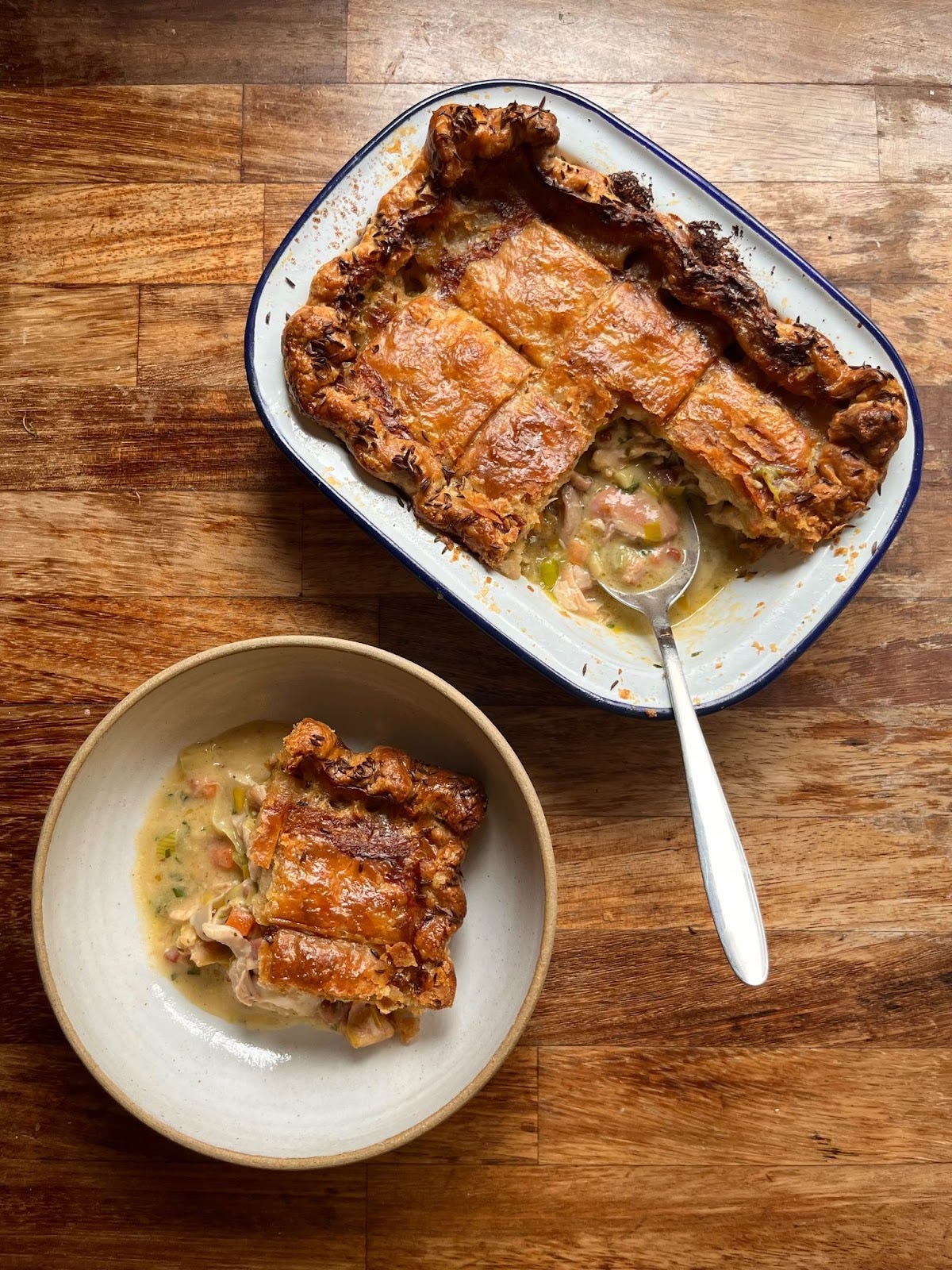
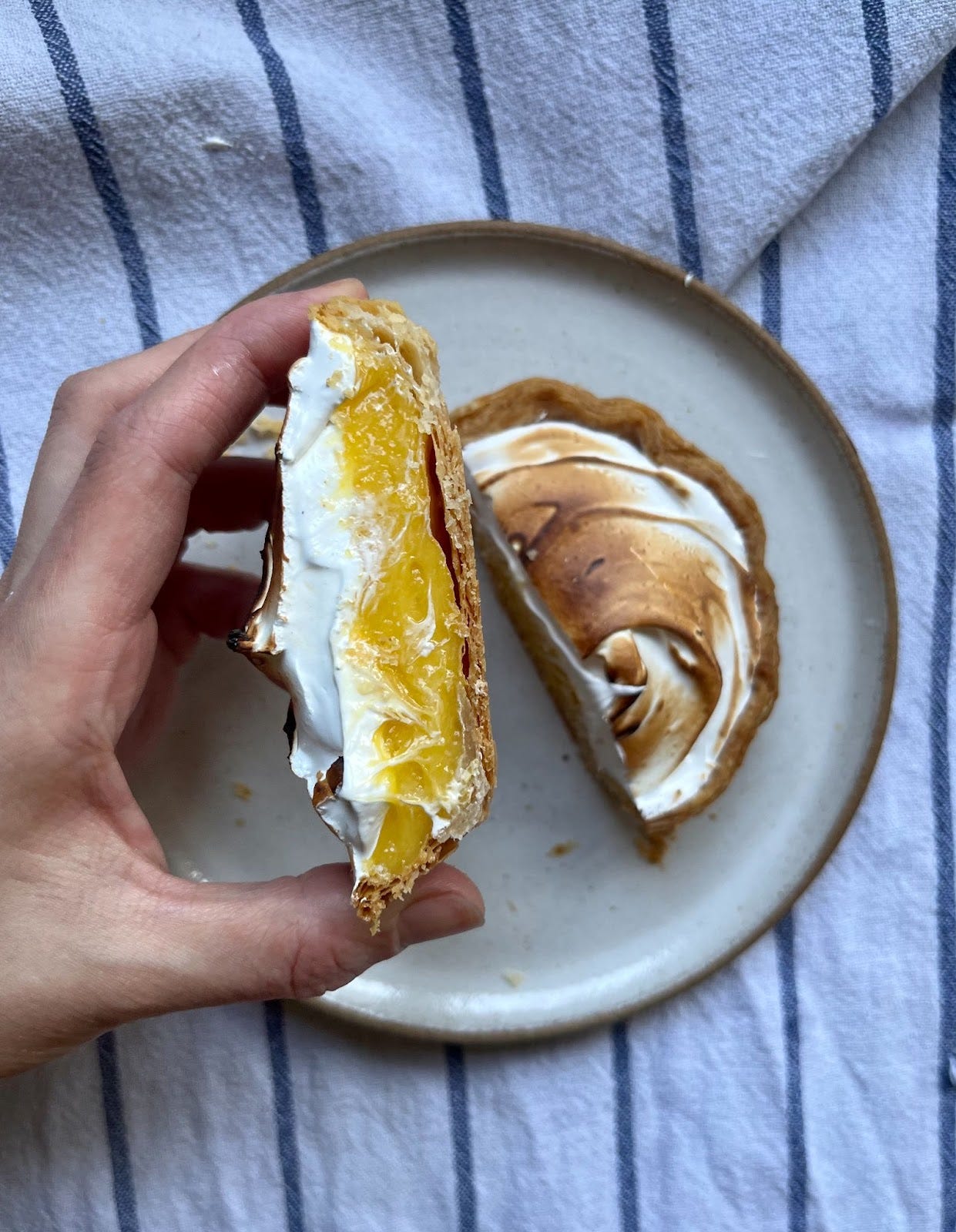
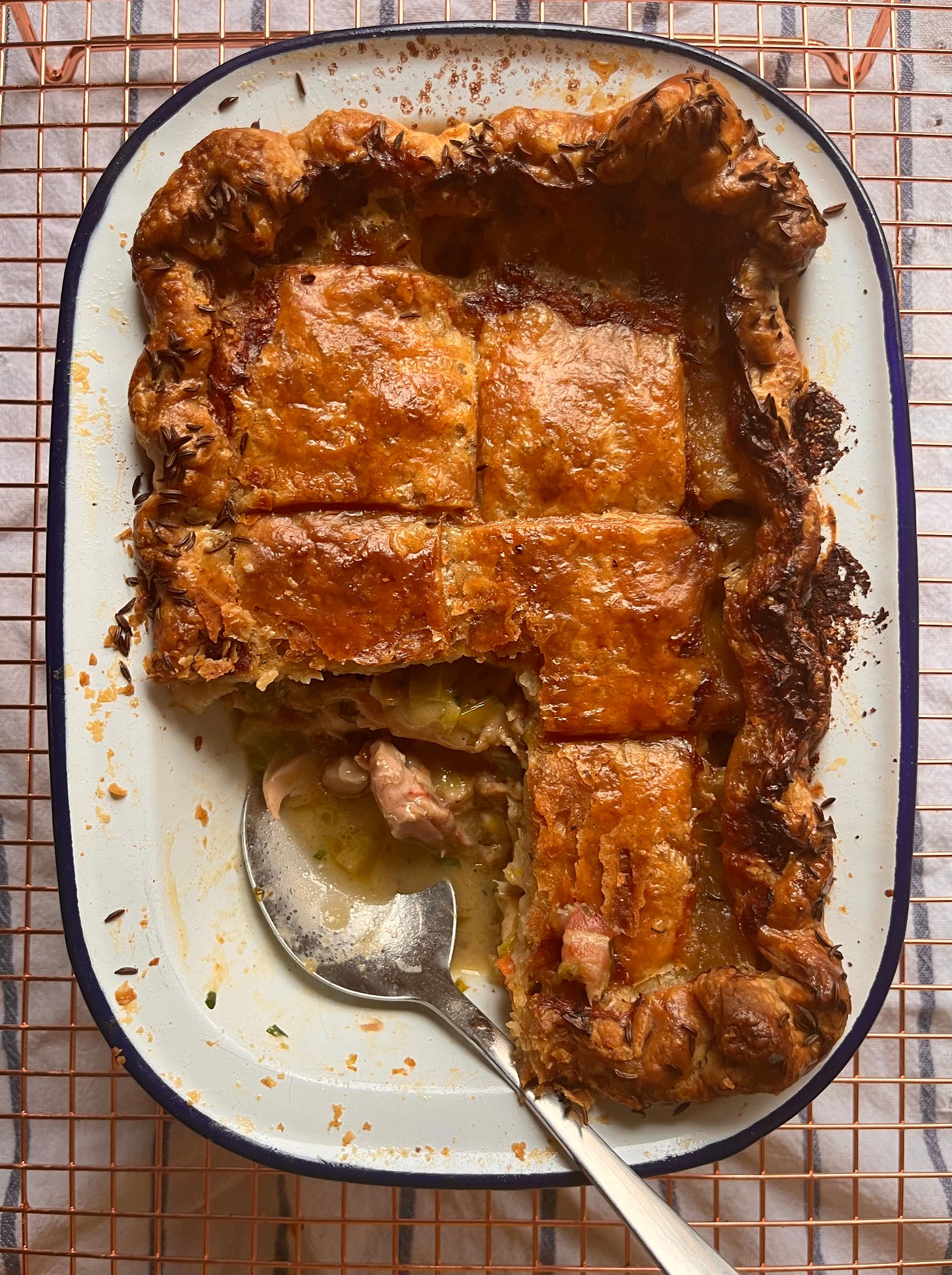


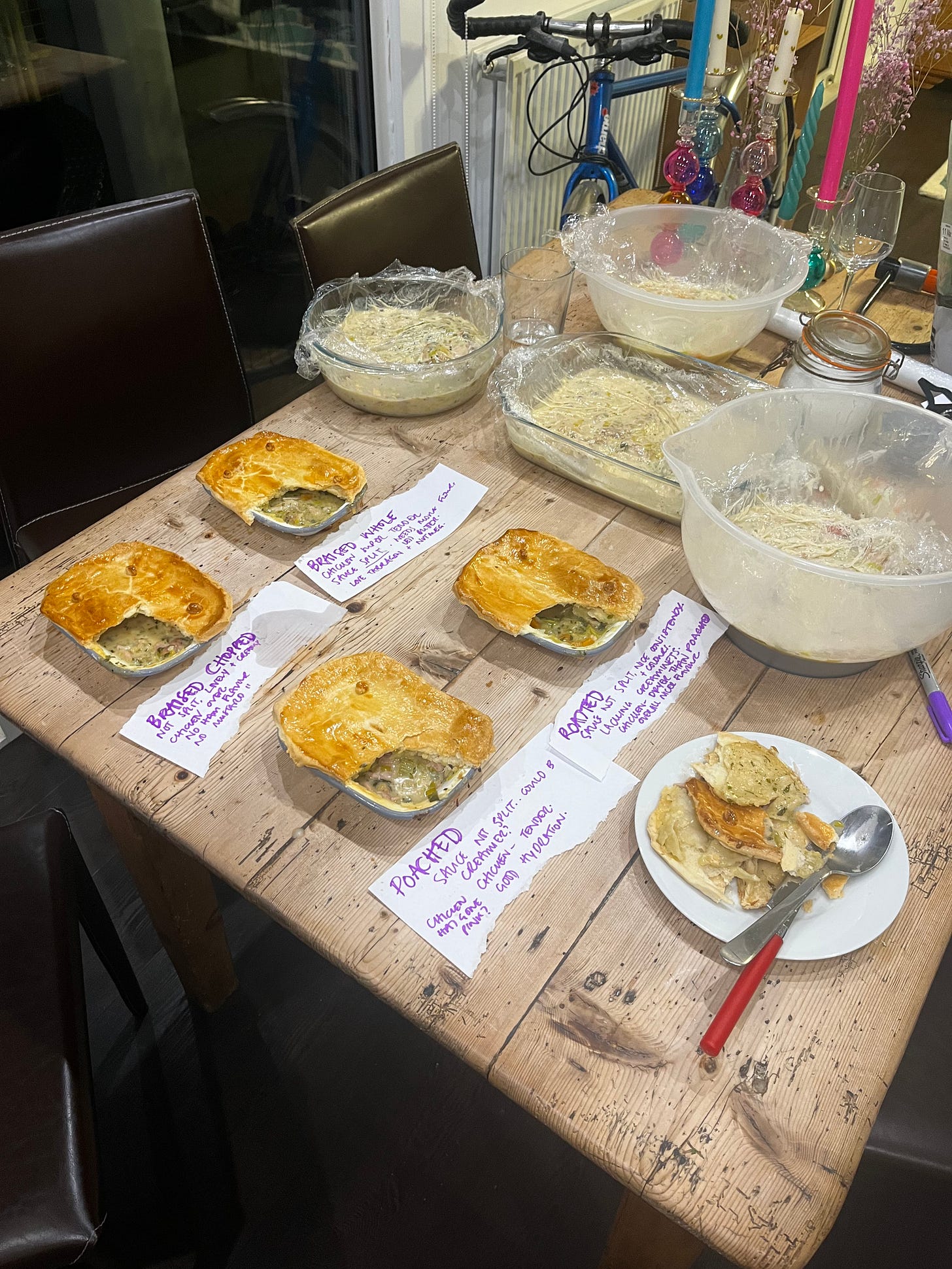
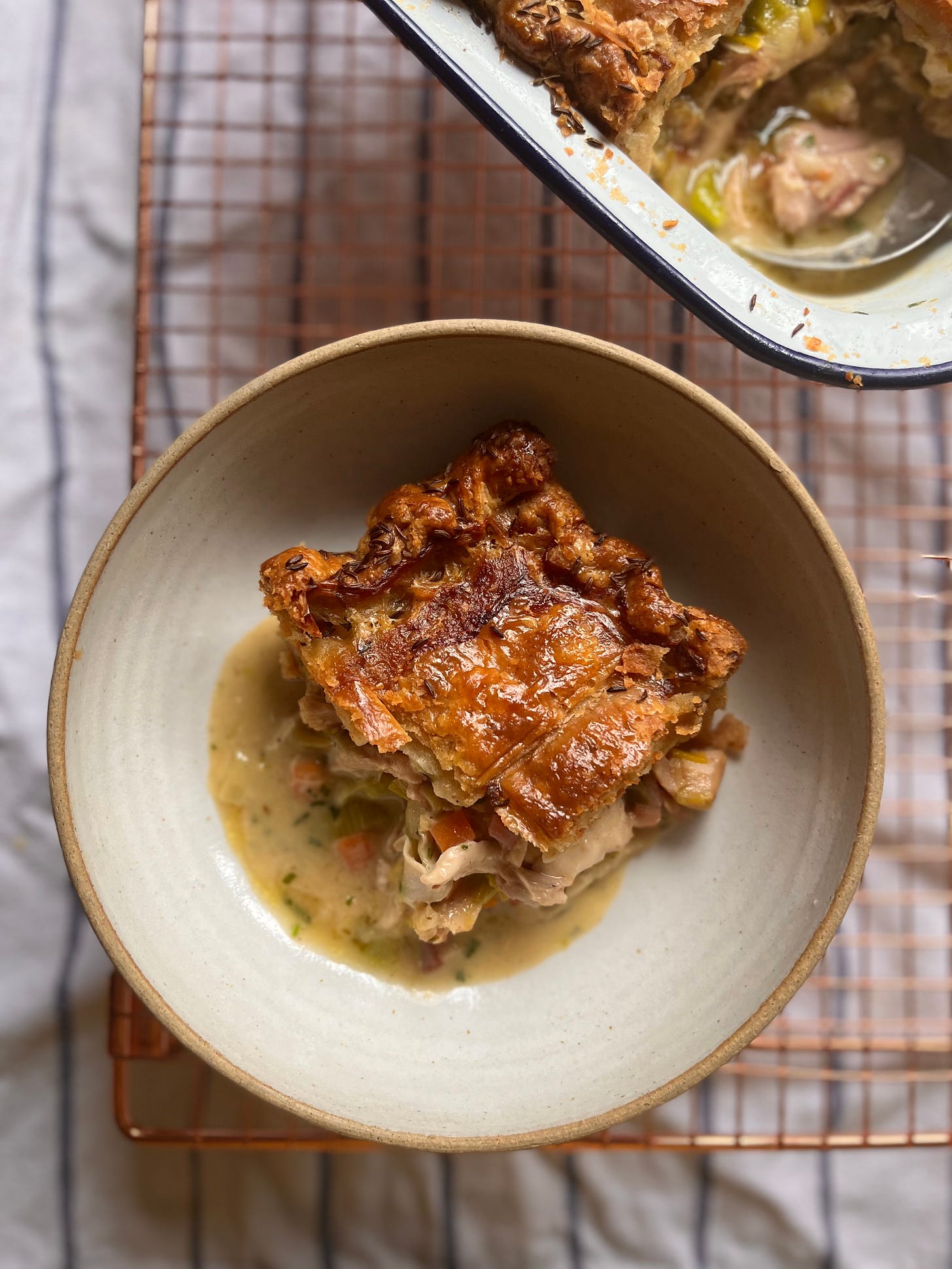
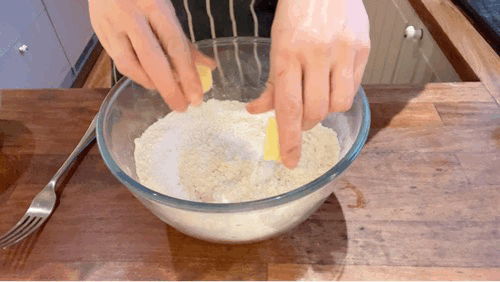
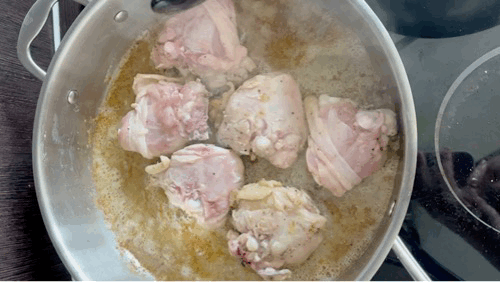
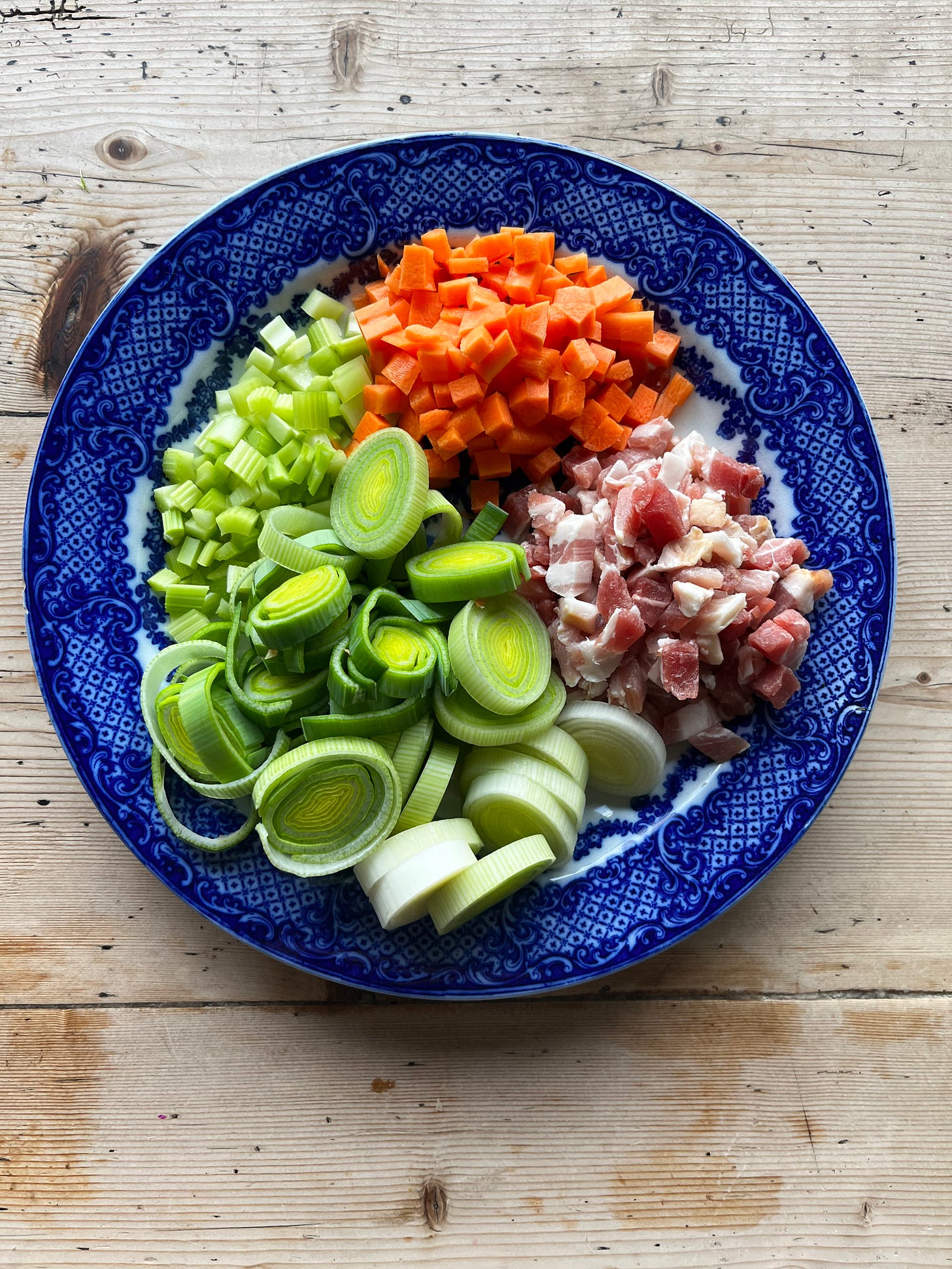
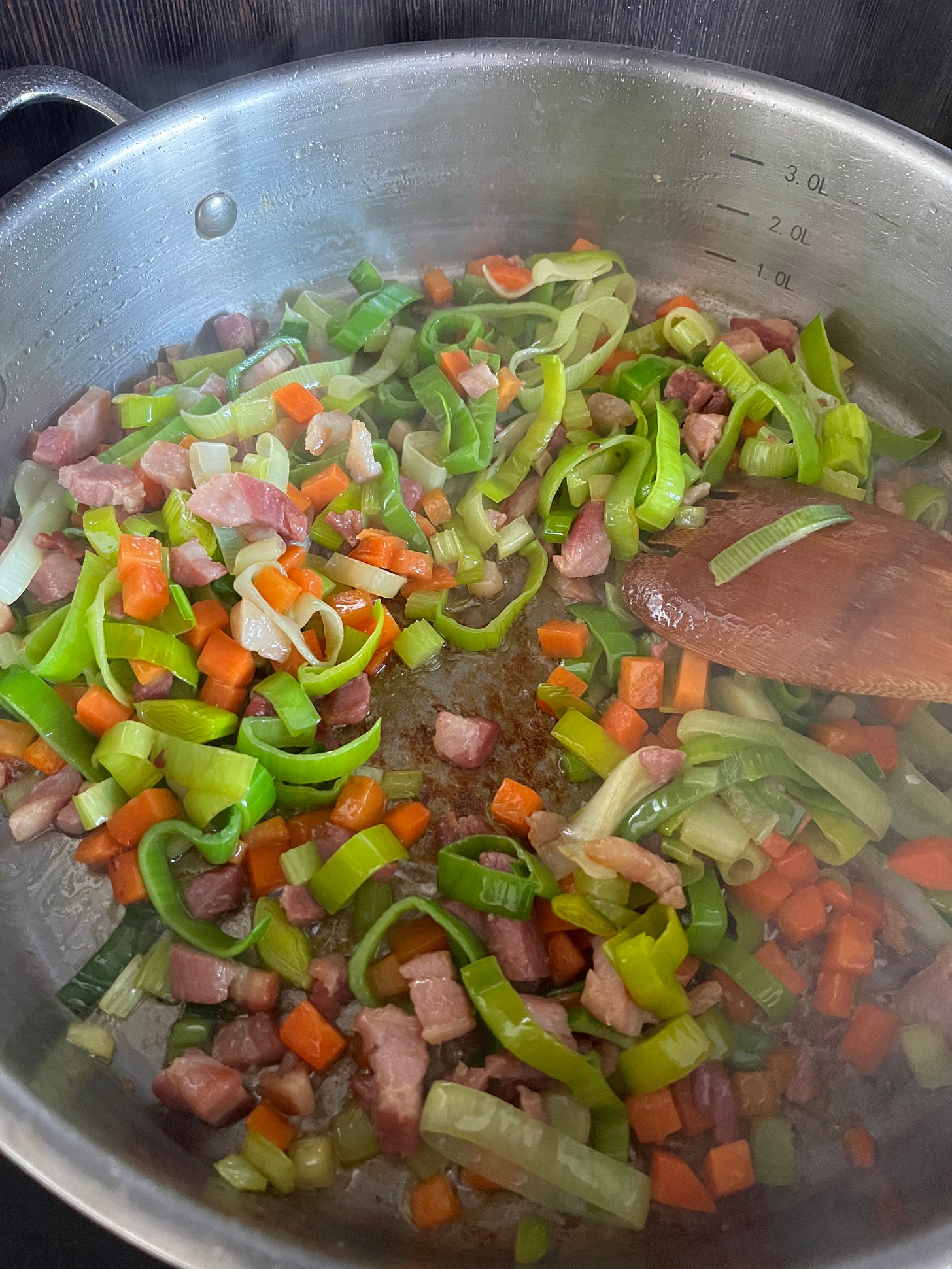
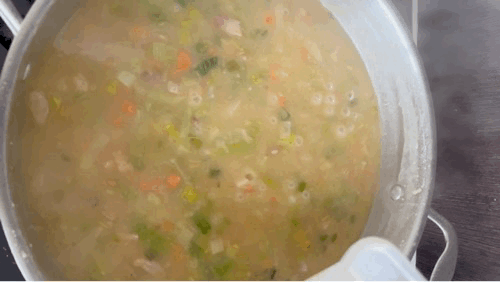
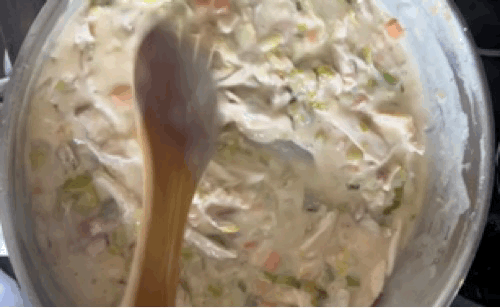

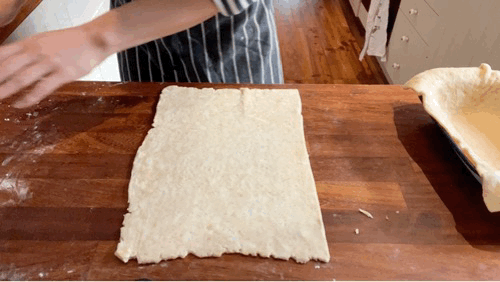
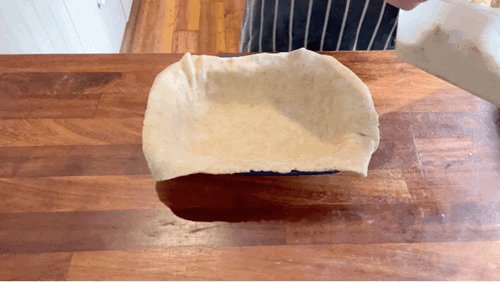
Hi! CAN’T WAIT TO MAKE THIS BAD BOI.
are you able to please clarify:
Where I’m at there’s no suet, and you mention that we can use butter only.
So which amounts of butter then is it?
• 75g of butter to replace suet + 80g of butter?
• Or is it ONLY 80g butter and omit the suet step totally?
Thank you!
I’m going to try this tomorrow night! Though there is no suet or tarragon to be found around here.. 😭